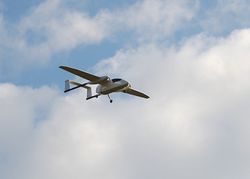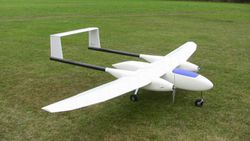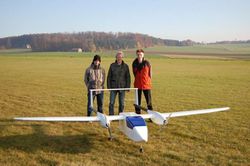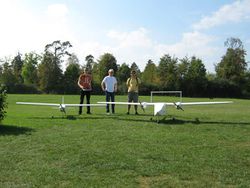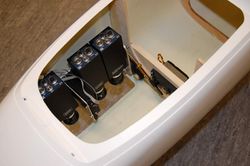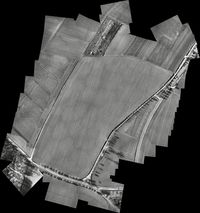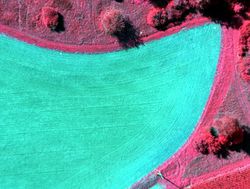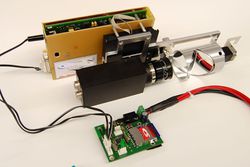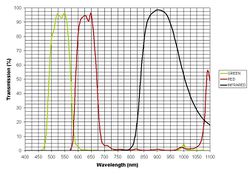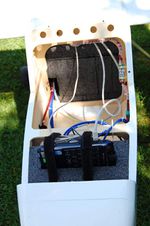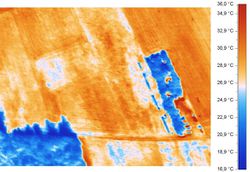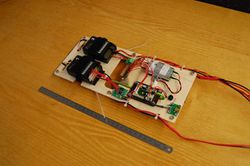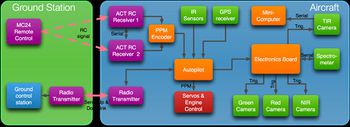Difference between revisions of "Adler Uni Stuttgart"
m (→Using Paparazzi: Corrected a typo.) |
|||
| (One intermediate revision by one other user not shown) | |||
| Line 74: | Line 74: | ||
== Using Paparazzi == | == Using Paparazzi == | ||
The first intention was to control the ''Adler'' manually and help the pilot with GPS and variometer. After some flights it turned out to | The first intention was to control the ''Adler'' manually and help the pilot with GPS and variometer. After some flights it turned out to be very hard to fly the straight lines needed for image acquisition with the pilot in the loop. <br> | ||
The search for an autopilot system led to paparazzi after investigating the possible commercial and free options. At that time only small airplanes had been flown with Paparazzi so we were not sure if it would work.<br> | The search for an autopilot system led to paparazzi after investigating the possible commercial and free options. At that time only small airplanes had been flown with Paparazzi so we were not sure if it would work.<br> | ||
After getting used to the system by flying an 'EasyGlider Pro' we started integrating it into the bigger planes. | After getting used to the system by flying an 'EasyGlider Pro' we started integrating it into the bigger planes. | ||
| Line 96: | Line 96: | ||
'''[http://paparazzi.enac.fr/wiki/User:Marc Wiki page of crew member]''' | '''[http://paparazzi.enac.fr/wiki/User:Marc Wiki page of crew member]''' | ||
[[Category: | [[Category:User_Projects]] | ||
Latest revision as of 21:10, 7 August 2011
The "Adler" is a project of the Institute of space systems (IRS) at University of Stuttgart.

|

|
Background
The reason for the IRS to develop and use UAV´s (which is not a "natural" thing for a space institute) derived from the fact that high quality and high resolution data of small spots or areas is required for certain tasks in remote sensing. The use of manned aircraft is not efficient for these tasks and too expensive for an institute to perform on a regular basis.
Missions
At the moment there are two missions performed with the airplanes
- BRDF-measurement: A special BRDF is a property of every surface in nature. The influence can for example be seen when images are stitched together for systems like Google Earth. At the borders visible contrast changes are noticable. The correction of these effects uses models which are developed using measured data. Most of these measurements where performed on the ground. When using airborne data, the influence of the atmosphere can be studied. The measurement should start in spring 2010.
- Precision farming: Using airborne data for agricultural applications could reduce the amount of fertilizer and pesticide needed for crop fields. In cooperation with a scientific farm we want to show that data of UAV´s can be used for these applications. Several flights with different instruments have already be conducted for this mission.
Airplanes
The airplanes were designed by students doing their thesis at the institute. They are specially constructed for their mission requirements.
Adler 1
The Adler is designed for stable and enduring flight. The size was needed for the required payload capacity and flight time.
It is built of styrofoam, wood and reinforcements.
- Basic data
- Wingspan: 4.33m
- Length: 2.66m
- Max. takeoff weight: 25kg
- Payload capacity: 7kg
- Engines: 2x PolyTec C42-62
- Batteries: 2x 10s2p 8000mAh
- Duration: 30+ minutes
Adler 2
The only difference to the first plane is a new fuselage with better aerodynamic shape. It is built of GRP in molds.
Trainer
As not many RC pilots fly planes the size of the Adler we wanted to have a plane for basic pilot training and for component testing. The goal of the design was to reproduce the flight characteristics of the bigger planes.
- Basic data
- Wingspan: 3m
- Length: 2.1m
- Max. takeoff weight: 14kg
- Payload capacity: 4kg
- Engines: PolyTec C42-62
- Batteries: 10s2p 8000mAh
- Duration: 30+ minutes
Payload
- Visual range cameras: Images are taken with three industrial black and white cameras equipped with special front end filters. This is necessary because normal colour cameras use Bayer filter for colour separation which are not usable for quantitative remote sensing. The channels used are green, red and near infrared (NIR). Especially the NIR is important for deriving biological parameters like the NDVI.
- Spectrometer: The three spectral channels of the cameras are supplemented by a 128 channel spectrometer with a range from 500 to 1000nm. The beam of the instrument is inserted to the view of one camera by a mirror system. A custom design electronic board controls the spectrometer when triggered by Paparazzi saves the data on a SD-Card.
- Thermal imager: When investiganting Water balance or right use of irrigation, the thermal imager is used. It can also detect animals for counting or fires. The resolution is quite low because of the sensors used. As the camera needs a windows PC to operate, we took apart an EEE-PC and control it by the Paparazzi system...
Using Paparazzi
The first intention was to control the Adler manually and help the pilot with GPS and variometer. After some flights it turned out to be very hard to fly the straight lines needed for image acquisition with the pilot in the loop.
The search for an autopilot system led to paparazzi after investigating the possible commercial and free options. At that time only small airplanes had been flown with Paparazzi so we were not sure if it would work.
After getting used to the system by flying an 'EasyGlider Pro' we started integrating it into the bigger planes.
System concept
As we use redundant control frequencies and special payload electronics we had to integrate Paparazzi using additional hardware. An overview can be seen in a picture. After some problems concerning the infrared sensors at the beginning we reached a stable working system and acquired much data in summer an fall of 2009.
Planned projects
The angular precision of the infrared sensors of Paparazzi is good for flying. The processing of images asks for a better knowledge of position and orientation. We will test an IMU-system for this task in 2010.
More information
UAV at university of stuttgart (Sorry, only german for now)
Gallery and videos
Contact
Wiki page of crew member
